Related Research Articles
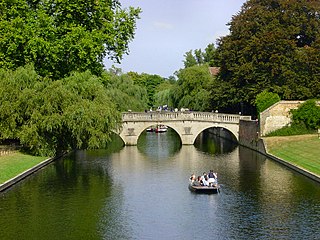
The River Cam is the main river flowing through Cambridge in eastern England. After leaving Cambridge, it flows north and east into the Great Ouse to the south of Ely at Pope's Corner. The Great Ouse connects the Cam to the North Sea at King's Lynn: The total distance from Cambridge to the sea is about 40 mi (64 km) and is navigable for punts, small boats, and rowing craft. The Great Ouse also connects to England's canal system via the Middle Level Navigations and the River Nene. In total, the Cam runs for around 69 kilometres (43 mi) from its furthest source to its confluence with the Great Ouse.

The House of Stuart, originally Stewart, was a royal house of Scotland, England, Ireland and later Great Britain. The family name comes from the office of High Steward of Scotland, which had been held by the family progenitor Walter fitz Alan. The name Stewart and variations had become established as a family name by the time of his grandson Walter Stewart. The first monarch of the Stewart line was Robert II, whose male-line descendants were kings and queens in Scotland from 1371, and of England and Great Britain from 1603, until 1714. Mary, Queen of Scots, was brought up in France where she adopted the French spelling of the name Stuart.

South Cambridgeshire is a mostly rural local government district of Cambridgeshire, England, with a population of 148,755 at the 2011 census. It was formed on 1 April 1974 by the merger of Chesterton Rural District and South Cambridgeshire Rural District. It completely surrounds the city of Cambridge, which is administered separately from the district by Cambridge City Council.

Muckross House is located on the small Muckross Peninsula between Muckross Lake and Lough Leane, two of the lakes of Killarney, 6 kilometres (3.7 mi) from the town of Killarney in County Kerry, Ireland. In 1932 it was presented by William Bowers Bourn and Arthur Rose Vincent to the Irish nation. It thus became the first National Park in the Irish Free State and formed the basis of the present day Killarney National Park.
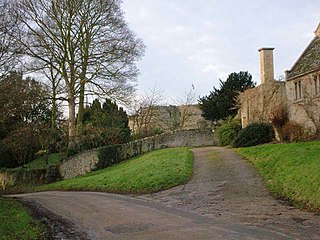
Barnwell Castle is a ruined castle, south of the town of Oundle, and west of the village of Barnwell, Northamptonshire. It has been designated by English Heritage as a Grade I listed building, and is a Scheduled Ancient Monument.
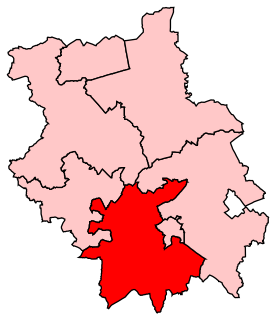
South Cambridgeshire is a constituency represented in the House of Commons of the UK Parliament since 2019 by Anthony Browne, a Conservative.

Bourne Castle was in the market town of Bourne in southern Lincolnshire.

Hallaton Castle was situated to the west of the village of Hallaton, which lies some 20 km to the south-east of the city of Leicester. It seems likely that the castle formed the administrative centre of an estate owned by Geoffrey Alselin, which is described in the Domesday Book, pinpointing the construction of the castle happening before 1086 but after 1066.

Hanley Castle was a Norman castle that stood to the south of the present-day site of the village of Hanley Castle, which lies 2 km north of Upton-upon-Severn, in the county of Worcestershire, England, United Kingdom..

Hereford Castle is a castle that used to be in the cathedral city of Hereford, the county town of Herefordshire, England. Founded sometime before 1052, it was one of the earliest castles in England. Hereford Castle was probably destroyed when the Welsh sacked Hereford in 1055, but seems to have been replaced by the following decade. During the civil war of King Stephen's reign, the castle was besieged three times; the garrison surrendered each time and control of Hereford Castle changed hands.
Huntington Castle was situated in the village of Huntington in Herefordshire, England, 2½ miles south-west of Kington.
Inkberrow Castle was situated in the village of Inkberrow in Worcestershire, some 10 km south of Redditch.
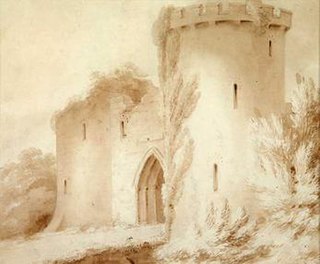
Knockin Castle is situated in the village of Knockin on Shropshire between Oswestry and Shrewsbury.
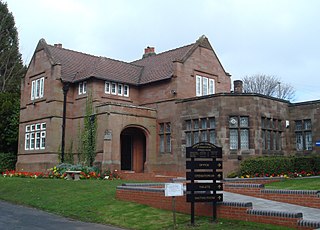
Lodge Hill Cemetery is a municipal cemetery and crematorium in Selly Oak, Birmingham, England. The cemetery was first opened by King’s Norton Rural District Council in 1895, and during the 1930s became the site of Birmingham's first municipal crematorium.

Claude d'Annebault was a French military officer; Marshal of France (1538–52); Admiral of France (1543–1552); and Governor of Piedmont in 1541. He led the French invasion of the Isle of Wight in 1545. Annebault was governor of Normandy and a very powerful figure during the reign of King Francis.

Old North Road was a railway station on the Varsity Line which served the small village of Longstowe near Bourn in Cambridgeshire. As its name suggests, the station was located on the eastern side of the Old North Road, the A1198 road - a major Roman road which linked London with Lincoln. Opened in 1862, the station was located in a rural area and saw little passenger traffic; it closed together with the line in 1968.
Bourn is a small village and civil parish in South Cambridgeshire, England. Surrounding villages include Caxton, Eltisley and Cambourne. It is 8 miles (12 km) from the county town of Cambridge. The population of the parish was 1,015 people at the time of the 2011 census.

The River Granta is the name of two of the four tributaries of the River Cam, although both names are often used synonymously. The Granta starts near the village of Widdington in Essex, flowing north past Audley End House to merge with the other contributary Rhee, which is also commonly called River Cam, a mile south of Grantchester. From source to its confluence with the Rhee it is 41.7 kilometres (25.9 mi) in length.

The Church of St Giles is a Grade II*-listed church in Cambridge, England. It is a Church of England parish church in the Parish of the Ascension of the Diocese of Ely, located on the junction of Castle Street and Chesterton Road. It was completed and consecrated by the Bishop of Ely in 1875, to replace an earlier church founded in 1092. The church, which added "with St Peter" to its appellation when the neighbouring St Peter's Church became redundant, is home to both an Anglican and a Romanian Orthodox congregation and is used as a venue for concerts and other events. It also serves as a main location of the Cambridge Churches Homeless Project.

Kingston and Bourn Old Railway or Kingston Amenity Area is a linear 1.9-hectare (4.7-acre) Local Nature Reserve between Kingston and Bourn in Cambridgeshire, England. It is owned and managed by Cambridgeshire County Council.
References
- History of Bourn
- Fry, Plantagenet Somerset, The David & Charles Book of Castles, David & Charles, 1980. ISBN 0-7153-7976-3
Coordinates: 52°11′18″N0°04′03″W / 52.18821°N 0.06757°W